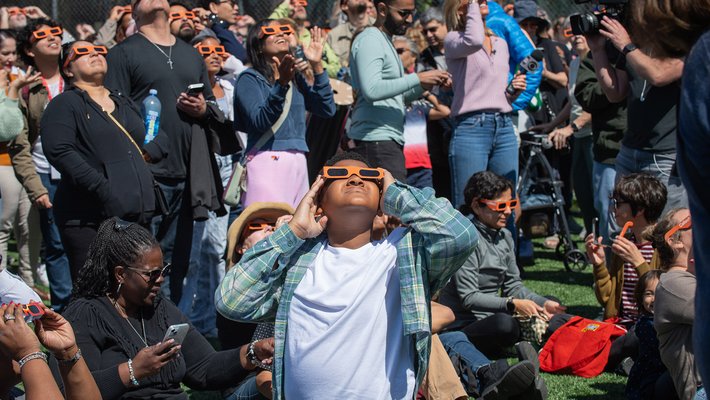Caltech Event Unites Thousands for Solar Eclipse Viewing
Solar eclipses are not only stunning and rare phenomena, but they are also central to our understanding of the cosmos: The 1919 total eclipse helped test Einstein’s theory of general relativity by allowing astronomers to observe starlight bending around the sun. And community events like the one on April 8, which was hosted by Caltech’s popular astronomy and astrophysics outreach program, give the public an opportunity to pursue scientific inquiry alongside Caltech researchers.
“It’s so important that we’re not just here doing science for scientists that only scientists have access to,” said Katherine de Kleer, assistant professor of planetary science and astronomy and Hufstedler Family Scholar. “Events like eclipses allow us to convey to the public the kinds of things that scientists do and share our excitement about stars and astronomy with our local community, both in Pasadena and in Los Angeles in general.”
This sentiment was echoed by researchers and volunteers who readily shared their knowledge with attendees, answered questions, guided guests through the stages of the eclipse, and facilitated observations through solar telescopes. “I think one of the big responsibilities that we have as scientists is to communicate our love and passion for science with the public,” said Sam Rose, a graduate student in astrophysics and volunteer with the outreach program. “Outreach events like this are a way to connect with people and really share that joy of discovery.”
Starting hours before the eclipse, science fans lined up around the Cahill Center for Astronomy and Astrophysics to receive a pair of free Caltech-branded eclipse glasses. “My favorite thing about volunteering at these events is answering people’s questions, clearing up misconceptions, and talking to them about their thoughts about astronomy,” said Xander Hall, a Caltech undergraduate student. “We get to witness the shock on their face when they learn that a sun spot can be the size of Earth.”
At the same time, a dozen Caltech scientists traveled to the path of totality of the eclipse to host educational activities along the Texas–Mexico border. Cameron Hummels, a computational astrophysicist and director of astrophysics outreach; and Rocio Kiman, Sherman Fairchild Postdoctoral Scholar Research Associate in Astronomy; co-organized the events in partnership with the Technological Institute of Piedras Negras. Caltech team presented two days of public science talks in Spanish and English, hosted a stargazing party, and guided over 2,000 local guests through the events of the eclipse with the help of solar telescopes and eclipse glasses, while live-streaming the event to thousands online. The weather cooperated and everyone present was able to experience the magic of a total solar eclipse and learn about the science that governs the world around us.
Caltech’s community outreach programs and public events serve as a bridge between the scientific community and the public.

